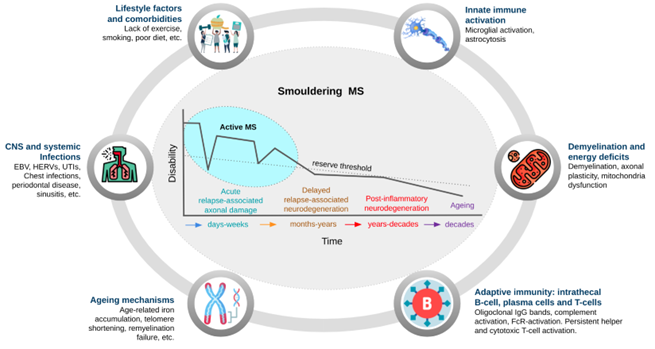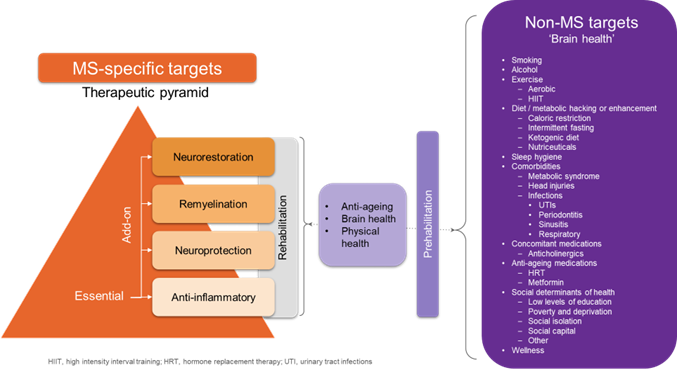The webinar
The fourth triMSx webinar, followed by a panel discussion, brought together five global experts and 622 registrants from 71 countries to discuss the latest data on smouldering multiple sclerosis (MS). The event included five succinct presentations, Q&A sessions and polling. This concise format provided convenience to time-poor researchers and clinicians who need to keep up to date with this fast-evolving area while allowing for lively and inclusive debate.
What exactly is smouldering MS?
Should smouldering MS be considered the ‘real MS’? This was a question raised following the opening presentation by Professor Laura Airas (Finland) that focused on the definition, pathology and clinical consequences of smouldering MS. Smouldering MS includes MS disability progression in patients who are relapse-free and exhibit neither gadolinium-enhancing T1-weighted lesions nor new or enlarged T2-weighted lesions on magnetic resonance imaging (MRI).
The clinical relevance of smouldering MS is fundamental. Smouldering disease is understood to affect the entire central nervous system (CNS) and is the dominant driver of disability worsening in MS. Smouldering lesions are associated with increased MS severity, more rapid disease progression, brain atrophy, worse clinical disability and worse prognosis, compared with the presence of lesions that are not chronically active.

It is therefore important that healthcare professionals have an understanding of the mechanisms that underlie smouldering MS. Explaining the pathophysiology, Professor Airas showed that compartmentalised, diffuse smouldering inflammation becomes trapped within the CNS. There is reduced trafficking of inflammatory cells from the periphery, and MS pathology spreads outside the focal lesions (which are visible on conventional MRI). Smouldering lesions are also described as chronic active lesions; they are characterised on non-conventional MRI by a full demyelinated core with inflammatory infiltrate around the lesion edge.
Professor Airas also highlighted the critical role of microglia in driving smouldering MS. Microglia are overactivated in a self-propagating cycle, leading to uncontrolled inflammation and chronic progression of neurodegeneration. Diffuse, smouldering inflammation from microglial activation can be detected using specific MRI techniques.
So, a key question is whether smouldering disease is the process involved in all forms of MS? Is it the ‘real MS’? The answer to that is probably ‘yes’, in the opinion of the presenters. The processes driving smouldering MS are most likely present in all patients from the beginning of MS pathology, even before the appearance of clinical symptoms. The clinical phenotypes of MS, namely relapsing–remitting MS (RRMS), secondary progressive MS (SPMS) and primary progressive MS (PPMS), overlie the pathological process occurring in patients, regardless of the MS designation.
How can we detect smouldering MS?
Professor Martina Absinta (Italy) gave a very clear summary of the emerging approaches to identify smouldering MS. Three promising imaging biomarkers can help identify the different, partially overlapping features of smouldering lesions. These are paramagnetic rim lesions (PRL), slowly expanding lesions (SEL) and translocator protein positron emission tomography (TSPO-PET) imaging.
The different features of the imaging biomarkers were presented by Professor Absinta. She explained that they represent a new window of opportunity for better visualising and monitoring of in vivo (micro)glial activity and chronic inflammation in MS. Professor Absinta emphasised that the imaging biomarkers have the potential to evaluate the efficacy of available disease-modifying therapies (DMTs) in treating chronic inflammation and in testing new treatments and new classes of agents that target glial activity. However, before these biomarkers can be used in routine clinical practice, further data are needed to inform guidance and education for neurologists and neuro-radiologists. Of interest, this is expected in the near future.
What is the role of ageing in smouldering MS?
The role of ageing mechanisms as key pathological drivers of smouldering MS processes was the focus of the presentation by Professor Antonio Scalfari (UK). Ageing processes in people lead to the progressive depletion of cognitive and brain reserve and the acceleration of brain atrophy. However, in MS, brain reserve is depleted more rapidly by the disease processes; thus, people with MS experience the impact of ageing earlier than people without the disease.
Professor Scalfari explained that although brain reserve can initially compensate for the effects of MS, this is lowered over time to a level at which it can no longer compensate. He stated that ‘age-related neurodegeneration is an important pathological driver underpinning the clinical manifestation of smouldering MS’. Specifically, impaired and reduced remyelination causes axons to be more vulnerable to irreversible degeneration. In addition, age-related iron accumulation within microglia is exacerbated in smouldering MS, leading to cellular damage. Iron also promotes the formation of reactive oxygen species and the release of pro-inflammatory cytokines, compounding the impact of MS disease processes. In closing, Professor Scalfari posited whether cellular senescence could become a target for neuroprotective treatments (senotherapy) in MS?
What does this mean for treatment decisions and holistic MS management?
Of key clinical interest are the potential therapeutic targets for smouldering MS. Are there DMTs available that could affect smouldering MS? Evidence suggests that certain DMTs that target B cells and CNS plasma cells and that promote remyelination could target pathological drivers of smouldering MS. These include cladribine, Bruton tyrosine kinase inhibitors and proteasome inhibitors. In addition, lifestyle changes (e.g. increased exercise, improved sleep hygiene, hormone replacement therapy, caloric restriction, intermittent fasting, ketogenic diets) and the prevention and treatment of certain comorbidities (e.g. cardiovascular disease, type 2 diabetes) could potentially have a direct benefit for people with MS. Further evidence is needed to fully elucidate the role of the various DMTs in the MS treatment armamentarium to effectively target smouldering MS.

An aim, and ongoing challenge, is to optimise the therapeutic management of MS for all patients with the early use of high-efficacy therapies to postpone, or at least reduce, smouldering pathology and slow MS progression. This would include patients who have progression without changes on conventional MRI.
In an impactful presentation, Ruth Stross (UK) emphasised the need to take a holistic management approach to improve outcomes for people with MS via a patient case study. Many patients with MS experience disease worsening that is under-recognised by many neurologists (e.g. disability progression, depression, cognitive decline), and the pivotal roles of anti-ageing and brain health are also undervalued, particularly given the impact of ageing mechanisms on smouldering disease processes. Ms Stross, referring to the World Health Organization 2022 position paper, highlighted the importance of optimising brain health, which can ‘not only reduce the prevalence and burden of neurological disorders but also improve mental and physical health overall’. Ruth explained that supporting patients’ brain health and lifestyle management, in addition to bolstering their self-determination and MS self-management strategies, can be combined with therapeutic strategies to optimise MS management and improve patients’ quality of life.
We were reassured that, at the end of the webinar, 96% of the attendees (compared with 78% at the start of the webinar) considered it extremely relevant for smouldering MS to be integrated into routine clinical practice. Half of the attendees will now always discuss smouldering MS with their patients as part of therapeutic decisions; this increased from 33%. As healthcare professionals, we need to educate ourselves on smouldering MS, given its importance and impact on the brain health and treatment of people with MS. We firmly believe that the future of MS treatment will be a combination of therapies and targeted brain health for better outcomes for patients.
About triMS.online
triMS.online is a virtual, free-of-charge, not-for-profit event series open to all MS researchers and healthcare professionals. Pioneered in 2018 by Gavin Giovannoni and the not-for-profit company Oxford Health Policy Forum, triMS.online has the mission of connecting a diverse global audience and advancing equality for all working in the field of MS. The series includes triMS.online conferences, triMSx webinars and triMSAudio podcasts.
The triMSx webinar ‘Smouldering MS: what is it and how to approach it?’ is available on demand in four languages.
The seventh triMS.online conference is planned for 25 May 2023.
References
- Giovannoni G, Popescu V, Wuerfel J, et al. Smouldering multiple sclerosis: the ‘real MS.’ Therapeutic Advances in Neurological Disorders. 2022;15. https://doi.org/10.1177/17562864211066751

